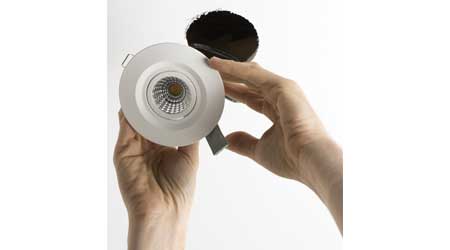A Primer on LEDs, Including Lamp Life and Light Output
First of a 3-part article on how to evaluate and implement LED light sources
The lighting industry has gone through many changes throughout its history, including the advent of halogen, compact fluorescent, and corrected-color high-intensity discharge (HID) light sources. While those legacy lighting sources are still in use, none has had the transformational impact that LED light sources are having on the industry and on facility managers today. This primer on how to evaluate LEDs, including lamp life and light output, can help facility managers navigate this change.
Semiconductor devices that produce visible light when an electrical current is passed through them, LEDs are fundamentally changing the way light is produced. In turn, they are changing the way lighting designers and electrical engineers, as well as facility managers, think of lamp life, serviceability, and replacement of light fixtures.
LEDs can substantially reduce lighting energy use while maintaining quality lighting, enabling lighting designers to realistically consider providing — and facility managers to gain the benefits of — net-zero energy commercial buildings.
The evaluation and implementation of LED light sources in a rush-to-market environment are tricky issues. Following is a guide to evaluating LED light sources across many different parameters — from color quality to life-cycle cost — with a focus on high-quality design that provides good value to the facility manager.
50,000-hour lamp life is a game-changer. Without the filaments that literally burn out in incandescent lamps or the phosphor that degrades over time in fluorescent, mercury vapor, and metal halide lamps, LED light sources have a lamp life of approximately 50,000 hours — up to 10 times that of a halogen incandescent lamp and up to double that of a linear fluorescent lamp. As a result, the frequency of lamp replacement and associated maintenance time and costs are significantly reduced.
Efficacy outshines legacy systems. In terms of their efficacy or light output measured as lumens per watt, LEDs (100-120 lumens per watt) outshine incandescents (40 lumens per watt) and fluorescents (60 to 80 lumens per watt). As a result, LEDs provide substantial energy savings on lighting, which typically consumes 25 percent of the electricity in a commercial office building. The lighting industry anticipates that LED efficacy will continue to improve, with a huge impact on energy use in commercial, industrial, institutional, and residential buildings.
White light provides accurate color rendering. The color appearance of objects under artificial lighting is an important characteristic of light sources. The Color Rendering Index (CRI) is an internationally accepted assessment that compares the appearance of a colored object under an artificial light source to its appearance under a reference light source. A CRI of 100 is considered to be the best CRI rating.
Today’s high-quality LEDs have the white light characteristic that meets user norms and expectations for color rendering in this regard. A CRI of 80 or above is appropriate for most applications, except for art, retail, and healthcare applications, where a CRI of up to 95 may be required. The higher the CRI, however, the less efficient the lamp, so the costs and benefits must be weighed to design a cost-effective lighting solution.
For example, LED lamps with a CRI of 80 might be used throughout a commercial installation, except where a higher CRI is required, such as lobby retail spaces and tenant reception areas where art is displayed.
Related Topics:














